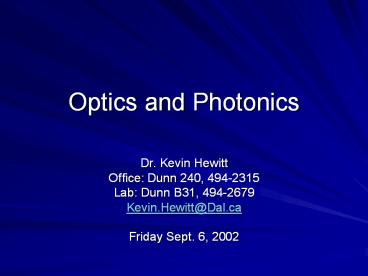Optics and Photonics - PowerPoint PPT Presentation
Title:
Optics and Photonics
Description:
Wave-Particle Duality. De Broglie (1924) 9. Young, Fraunhofer ... But the relation c = is just what we expect for a harmonic wave. 16. Wave-particle duality ... – PowerPoint PPT presentation
Number of Views:138
Avg rating:3.0/5.0
Title: Optics and Photonics
1
Optics and Photonics
- Dr. Kevin Hewitt
- Office Dunn 240, 494-2315
- Lab Dunn B31, 494-2679
- Kevin.Hewitt_at_Dal.ca
- Friday Sept. 6, 2002
2
Course Information
- Optics is light at work
- Textbook Optics (4th edition), Eugene Hecht,
152.39 - Reference Introduction to Optics, F. L.
Pedrotti, - Description Two areas will be covered
- Geometrical optics ? lt dimension of
aperture/object - Wave (i.e. physical) optics ? gt dimension of
aperture/object - Selected topics
- What are your areas of interest?
- Lasers, holography, fiber optic communication,
functions of the eye - Pre-requisites PHYC 2010/2510 and MATH 2002
3
Course Information
- Grading
- Problem sets 20
- Midterm 20
- Oral Presentation 20
- Final exam 40
- Problem sets
- 1 per week
- Hand-out/Hand-in every Wednesday (begin Sept. 11)
4
Class Schedule
Week Dates Topic Key terms
1 Sept. 6 The Nature of light Wave-particle duality
2 Sept. 9-14 Geometrical optics Huygens and Fermats principles Reflection, refraction, thin lens
3 Sept. 16-21 Matrix methods in paraxial optics System matrix elements, thick lens, cardinal points, Ray transfer matrix
4 Sept. 23-28 Optical instrumentation Optics of the eye Stops, pupils, windows, prisms, cameras, telescopes, Acuity, corrections
5 Sept. 30-Oct. 4 Wave equations and superposition Plane and EM waves, Doppler effect
6 Oct. 7-12 Interference of light Youngs double slit, Dielectric films, Newtons rings
7 Oct. 14-19 Optical Interferometry Michelson, Fabry-Perot, Resolving power, Free spectral range.
5
Class Schedule
Week Dates Topic Key terms
8 Oct. 21 -26 Fraunhofer diffraction Single slits, multiple slits, rectangular and circular apertures
9 Oct. 28-Nov.1 Gratings Grating equation, Free Spectral Range, Dispersion, Resolution
10 Nov. 4 - 9 Polarization of light Fresnel equations, Jones vector, birefringence, optical activity, production
11 Nov. 11 - 16 Laser basics and applications Einsteins theory, Laser Tweasers
12 Nov. 18 - 23 Fiber optics Fourier optics Bandwidth, attenuation, distortion, optical data imaging and processing
13 Nov. 25 -30 Holography Class Presentations
14 Dec. 2 Classes end
15 Dec. 4 - 14 Exam period 3 hour exam
6
Key Dates
Date Item
September 20 Last Day to Register
October 7 Last Day to Drop without a w
October 14 Thanksgiving Day
October 12 Midterm exam
November 11 Remembrance day
November 4 Last Day to drop with a W
Nov. 25-30 Oral Presentations
December 2 Classes end
December 4-14 Exam period
7
Nature of Light (Hecht 3.6)
8
Nature of Light
- Particle
- Isaac Newton (1642-1727)
- Optics
- Wave
- Huygens (1629-1695)
- Treatise on Light (1678)
- Wave-Particle Duality
- De Broglie (1924)
9
Young, Fraunhofer and Fresnel(1800s)
- Light as waves!
- Interference
- Thomas Youngs (1773-1829) double slit experiment
- see http//members.tripod.com/vsg/interf.htm
- Diffraction
- Fraunhofer (far-field diffraction)
- Augustin Fresnel (1788-1827) (near-field
diffraction polarization) - Electromagnetic waves
- Maxwell (1831-1879)
10
Max Plancks Blackbody Radiation (1900)
- Light as particles
- Blackbody absorbs all wavelengths and
conversely emits all wavelengths - The observed spectral distribution of radiation
from a perfect blackbody did not fit classical
theory (Rayleigh-Jeans law) ? ultraviolet
catastrophe
11
Cosmic black body background radiation, T 3K.
12
Plancks hypothesis (1900)
- To explain this spectra, Planck assumed light
emitted/absorbed in discrete units of energy
(quanta), - E n hf
- Thus the light emitted by the blackbody is,
13
Photoelectric Effect (1905)
- Light as particles
- Einsteins (1879-1955) explanation
- light as particles photons
14
Luis de Broglies hypothesis (1924)
- Wave and particle picture
- Postulated that all particles have associated
with them a wavelength,
- For any particle with rest mass mo, treated
relativistically,
15
Photons and de Broglie
- For photons mo 0
- E pc
- Since also E hf
- But the relation c ?ƒ is just what we expect
for a harmonic wave
16
Wave-particle duality
- All phenomena can be explained using either the
wave or particle picture - Usually, one or the other is most convenient
- In OPTICS we will use the wave picture
predominantly
17
Propagation of light Huygens Principle (Hecht
4.4.2)
- E.g. a point source (stone dropped in water)
- Light is emitted in all directions series of
crests and troughs
18
Terminology
- Spherical waves wave fronts are spherical
- Plane waves wave fronts are planes
- Rays lines perpendicular to wave fronts in the
direction of propagation
Planes parallel to y-z plane
19
Huygens principle
- Every point on a wave front is a source of
secondary wavelets. - i.e. particles in a medium excited by electric
field (E) re-radiate in all directions - i.e. in vacuum, E, B fields associated with wave
act as sources of additional fields
20
Huygens wave front construction
Construct the wave front tangent to the wavelets
What about r direction? See Bruno Rossi Optics.
Reading, Mass Addison-Wesley Publishing Company,
1957, Ch. 1,2 for mathematical explanation
21
Plane wave propagation
- New wave front is still a plane as long as
dimensions of wave front are gtgt ? - If not, edge effects become important
- Note no such thing as a perfect plane wave, or
collimated beam

